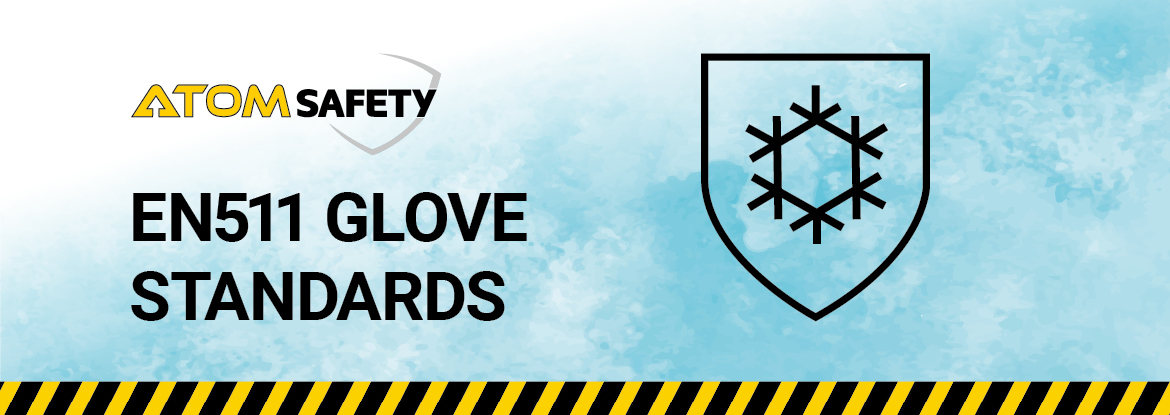EN511 is a European glove standard that is utilised in Australia to measure how well a glove can withstand cold temperatures. It is just as important to protect your hands from cold burns in cold environments as it is to protect your hands from extreme heat. This goes beyond just finding work gloves that keep hands warm, but rather finding gloves that will protect hands from being harmed in cold environments. EN511 PPE glove standards only apply to gloves that provide protection to a user’s hands against convective and contact cold down to temperatures of - 50°C.
Gloves that show the below EN511 pictogram must have achieved a minimum performance level of 1 for abrasion and tear resistance under the EN388 glove standard. You will see numbers displayed underneath the pictogram. These numbers represent the grade the glove achieved in relation to 3 tests. The higher the level, the better the thermal capabilities of the glove are.
|
 |
The testing criteria for protection from cold includes the following:
A = Resistance to convective cold (Performance level 0-4)
B = Resistance to contact cold (Performance level 0-4)
C = Permeability by water (Level 0 or 1)
An example of how these results would be displayed on a glove is shown on the image below. If any of these numbers on the glove are replaced with an X or N/A, this does not mean the glove failed the test but rather that it has never been tested for that particular hazard.

A = Resistance to Convective Cold (Performance level 0-4)
This test indicates how well a glove will insulate and maintain hand temperature against the surrounding cold air. This is measured based on the transfer of cold through the glove via convection. To conduct this test the glove is placed on an electrically heated mannequin hand that measures the amount of power required to maintain between 30°C and 35°C (body temperature) in a controlled chamber.
The chamber is cooled down to 20°C below that of the heated hand while constant air flow is applied. To arrive at the final score, the electrical power required to maintain a constant temperature between the surface of the heating hand and the atmosphere in the chamber is measured. The more electrical power that is required, indicates that the glove provides lower levels of thermal insulation.
The glove will be given a performance level of 0-4, with 4 being the highest level, and 0 meaning it failed the test. Below is a table that provides a more detailed explanation of how the test determines the convective cold levels in a glove.

*m2°C/W= Watt per square metre per degree Celsius - This is a metric unit of the heat transfer coefficient. ITR= Infrared Thermography- this is a method of measuring thermal insulation properties.
B = Resistance to Contact Cold (Performance level 0-4)
This test measures how protective the glove is when it is put into direct contact with a cold source or object. To conduct this test the glove material is placed between a warm plate and a cold plate. A cold extractor fan is used to further cool down both the plates. The measured temperature drop across the objects being tested is then used to calculate the glove's thermal resistance to contact cold. These results are compared to a reference standard to decide the glove's final level.
Like the convective cold test, the glove will be given a performance level of 0-4, with 4 being the highest level, and 0 meaning it failed the test. Below is a table that provides a more detailed explanation of how the test determines the contact cold levels in a glove.
C = Permeability by Water (Level 0 or 1)
This tests whether your hands will be safe from water leaking through the glove. This test is simply a pass or fail; gloves that receive a 0 fail and gloves that achieve a 1 pass.
To conduct this test, the glove is submerged into water for 30 minutes. If the water does not leak through the glove’s material, then it will pass will a level 1 rating. If the glove fails with a level 0 rating, it does not necessarily mean the glove does not perform highly in the other EN511 areas and therefore, it can still qualify as a thermal resistant glove. However, if you were looking for thermal waterproof work gloves, then it would be important to choose a glove that’s achieved a level 1 rating for permeability by water.
Below is a table that provides an explanation of how the test determines the permeability by water in a glove.

Having an understanding of the EN511 Standard will help you to find the right cold protective gloves for your workplace, whether you’re after heavy duty freezer gloves or general winter work gloves.
If you are not sure what gloves are required in your workplace, contact the ATOM Safety team to discuss your requirements and find the right solution for you.




